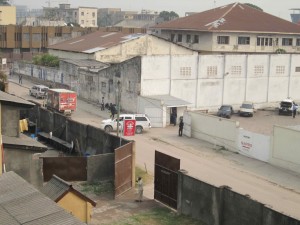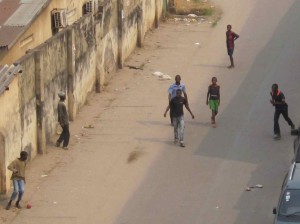I woke up at the Caritas hospitality center on July 13. I had not slept well, due to the time change and the fact that I had just finished a 20-hour succession of flights. The center was a safe environment, separated from the Kinshasa streets by a high wall. There Caritas,the largest Christian aid group in Africa, has its offices and warehouses, and the Conference of Congolese Bishops has its meeting rooms. Our bedrooms even had private baths, and there was a restaurant that served breakfast, lunch, and dinner.
From the fourth floor of the Caritas Center, I looked down on the Kinshasa street, and saw a group of boys playing soccer. It could have been a scene from home, except for the high walls lining the streets and the lack of sidewalks. The boys were engaged in their match, and never looked up to see the visitor, high above them, shooting pictures. I felt disconnected. Even if I were on the street, and could speak French fluently, could I have engaged them in conversation? What would I have said?
Later that day, Bishop Djomo’s driver took us to the handicraft market. There were dozens of stalls, selling tribal masks, woven mats, carved wooden objects, paintings, and jewelry including malachite bracelets. It was a bit of culture shock — the vendors crowded around us, beseeching us to look at their wares. I didn’t know what I wanted to buy, and so I just “window shopped” — afterwards, I regretted my indecisiveness, because I was never able to return to the market.



